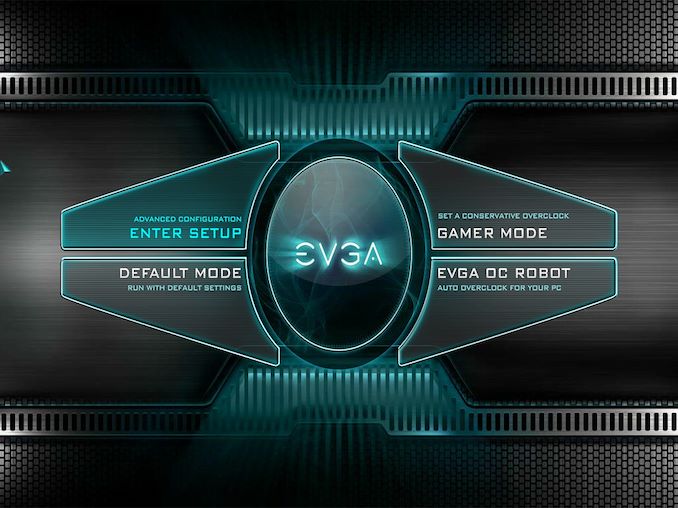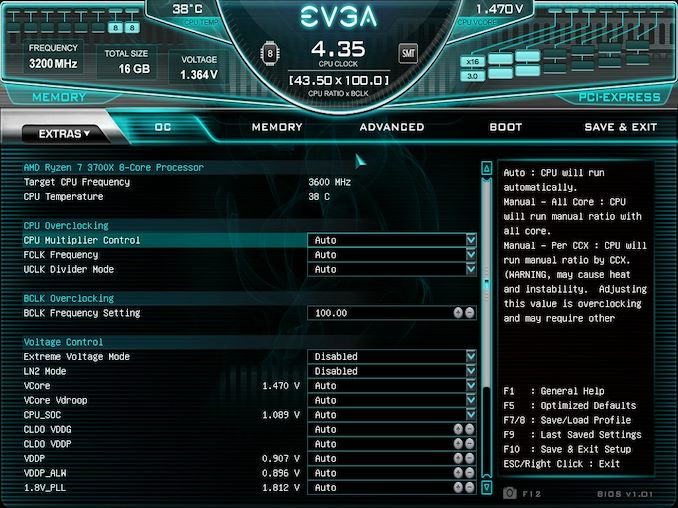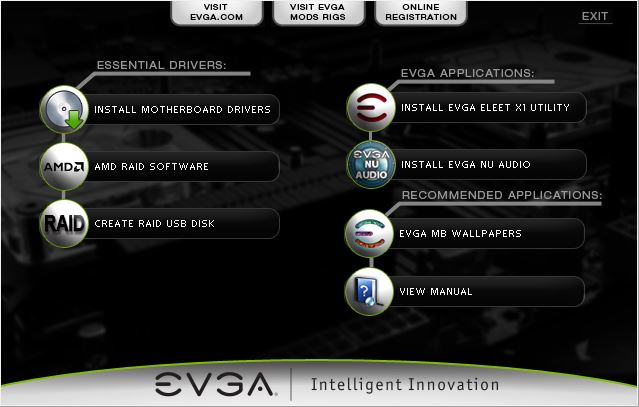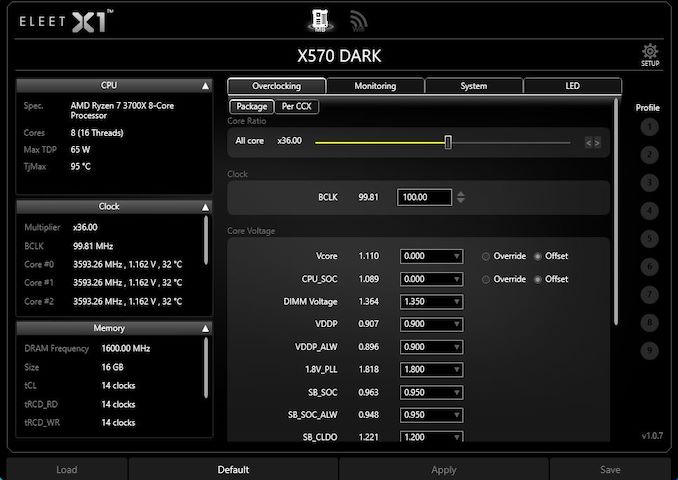The EVGA X570 Dark Motherboard Review: A Dark Beast For Ryzen
by Gavin Bonshor on October 8, 2021 8:00 AM ESTBIOS
Upon entering the BIOS on the EVGA X570 Dark, it has a beautiful GUI, listing four main sub-entry points into the firmware. The GUI itself is based around EVGA's primary color scheme, including turquoise, greys, blacks, with white text.
Looking at the four main options for users to select from when first entering the firmware, users can choose enter setup, which opens up all of the motherboard's settings. Users looking to just get on with things without making customizations can simply select the Default Mode option. On the right-hand side, users can select Gamer Mode, which applies a moderate overclock, or users can choose the EVGA OC Robot, which lets the firmware tweak and change things for maximum performance.
Using the Enter Setup option from the initial splash screen takes you straight to the overclocking settings available on the board. Within this section of the firmware, users can overclock the processor, with memory options located in the next tab. There's plenty for users to customize, including CPU Core frequency, BCLK frequencies, as well as a large selection of voltages with an LN2 mode available for users to select from. Note, don't enable LN2 mode unless you're using sub-ambient cooling methods, as this may cause damage to processors in normal circumstances.
In terms of memory options, users can enable X.M.P. 2.0 profiles on compatible kits of memory, customized frequency, the Infinity Fabric (FCLK) frequency, and various primary, secondary, and tertiary latencies. In the advanced section of the firmware, users can change storage options, enable Resizable B.A.R. support, and enable or disable the onboard controllers.
Users can customize the fan profiles on each of the eight 4-pin fan headers within the advanced section. EVGA also includes dual two-digit L.E.D. debuggers, which can actually display information such as CPU VCore, CPU temp, and even V.R.M. temp in real-time. Users can turn this off if they wish to do so, but in our testing, this was handy to monitor V.R.M. temperatures as the sensor itself doesn't currently work with HWInfo; this could change in a later revision however.
Overall the EVGA firmware is functional, easy to navigate, and responsive to our USB keyboard and mouse. It's very focused on performance, with various options designed for users to achieve this.
Software
With the decline in optical media usage, EVGA includes a small USB stick within the accessories bundle, which contains drivers and software for users. We wish more companies would do this, with just select models from select vendors offering this.
Plugging in the inclusive USB drive and clicking on the executable file brings up a list of options. These allow users to install essential drivers, including AMD's RAID software, with other possibilities, including EVGA's ELEET X1 overclocking utility, EVGA's N.U. Audio software, and even includes EVGA flavored wallpapers for users to install.
Looking at the EVGA ELEET X1 software, the utility amalgamates various elements, including overclocking, system monitoring, and control of both the integrated RGB LEDs and external ones users choose to install. There's plenty of overclocking options for users to customize, and provides a more comprehensive set of options than AMD's own Ryzen Master software. Options include CPU frequency (all-core only), CPU VCore, DRAM voltage, SoC, VDDP, P.L.L., and these can be adjusted without rebooting the system.
Overall, EVGA's software package is light compared with some of the competition. Still, the board is marketed for extreme overclocking, maximum performance, and as such, the software that comes included is more than ample.



























36 Comments
View All Comments
Eliadbu - Saturday, October 9, 2021 - link
Or RGB, but it has 2nd NIC and m.2 key E (incase you want to add wifi card).jtd871 - Friday, October 8, 2021 - link
AFAIK, RAM overclocking is more stable when you are using only 2 sticks, and this is a 'halo' board designed primarily for competitive overclocking.You wouldn't use a top-fuel dragster as your daily commuter car or to show up to a formal red-carpet event. In the same way, this board is not intended for 'normal' computing or gaming.
Threska - Friday, October 8, 2021 - link
Now I'm just waiting for the workstation/server version.WaltC - Friday, October 8, 2021 - link
I couldn't believe that I read this sentence in the review of this mboard:"While these comments make sense, ultimately very few users apply memory profiles (either XMP or other) as they require interaction with the BIOS."
There will be zero (0) customers of this motherboard who will decline to use the bios...;) Every single one of them will be quite conversant with the bios and eager to use it.
Seem to be a lot of this kind of general assumptions here that really have no relevance for the people who will be buying this product.
WaltC - Friday, October 8, 2021 - link
If I missed the place where you discussed a dual bios on this motherboard, or its lack of one, I beg pardon. But there are a lot of interesting DIP switches visible on this motherboard and a brief explanation would have been nice. Also, why would you test a 65W CPU with this board? Seems like a 5900X or 5950X would have been far more interesting, not to mention in keeping with the type of CPU a customer of the $690, OC'ing board is much more likely to purchase.I did agree with your conclusion, though, about boards costing half as much having very similar features and options--for instance, my two-year old x570 Aorus Master ($350) includes both the RT 1220-VB HD & a headphone AMP for onboard sound, but the x570 Master also includes a hardware DAC, the SABRE 9118, while the EVGA board lacks a hardware DAC. The Master includes 4 DIMM slots, and a manually switched dual-bios setup--which in my estimation is just about a requirement for an overclocking board--which the Master is, even though it doesn't have the VRM chops of this EVGA board. But my Master was shipped on the same day that Zen2 CPUs shipped from AMD, so I think the EVGA board is targeting upper-end Zen3 CPUs for OC'ing.
But as I mentioned earlier, trust me when I say that nobody will be buying a $690 OC'ing board who is afraid to go into his bios...;) Glad to see EVGA supporting AMD again, and like you, it will be nice to see a range of AMD4/5 EVGA board products at some point.
Oxford Guy - Saturday, October 9, 2021 - link
"While these comments make sense, ultimately very few users apply memory profiles (either XMP or other) as they require interaction with the BIOS."Stuff like this is a gift (of hilarity) that keeps on giving.
Silver5urfer - Friday, October 8, 2021 - link
There are few things, first this board doesn't use ASM SATA controller, I think you should correct that. All 8 SATA ports are from chipset only. The extra PCB for LN2 also shows the same, Manual also states the same.Now moving on to the board vs Z590 DARK. They removed one NVMe M.2 slot on this, Downgraded the phases and smaller Aluminum heatsink instead of massive Copper block on Interl board, then we have the rear DP and HDMI removed.
Next, the bigger things. First is the USB ports, the board has rear I/O from Chipset only. None of them are from CPU. Usually all X570(S) boards have ton of CPU USB ports, EVGA chose not to for this board. I can guess the only reason being AMD Ryzen 5000 CPUs have issues with the USB ports dropping and all sort of bugs, still not ironed out. So they avoided those, but the front I/O panel ports will be from CPU only, on top they dropped the ASMedia controller for USB C unlike the Z590 DARK. They also dropped the U.2 port.
Next is why they did they go with the Dual DIMM slots, Ryzen doesn't do well with Dual Rank B-Die kits unlike Intel which likes them. Now we have to be too cautious on that part due to the Zen 3 IMC. Now the price, it's highway robbery period. The board is exactly priced at X570 Aorus Xtreme at $700 which not only packs everything this has but even more. Plus it also has the 10G LAN, on top of the HiFi DAC which is not that buggy trash ALC4080 class, instead ALC1200 like this. Crosshair VIII Extreme is $100 more but it has more features, however it has that dreaded garbage ALC4082 and all that ASUS bloatware for the proper functioning of the DAC/AMP hardware. These guys should have included a 10G LAN port at-least, they really are saving a ton of cash on this board, simply a Z590 DARK based PCB design with extra PCIe 4.0 M.2 drive and much more reduced components and choices vs Intel board.
Coming to review, surprised on the DPC latency of this board. Now I'm just waiting on how this board does, esp related to the AMD Ryzen stability with Memory and OC AND USB. Also it's a shame that there's no Ryzen 5000 used for review and no Memory tuning as well. Everything this board got going is all about OC and unlocking potential...
leexgx - Friday, October 8, 2021 - link
If you use 2x dual rank sticks (anything above 16gb per stick) is exactly the same as using 4x8gb single rank sticks (because it's in dual rank due to 2 single ranks per channel)The point of this motherboard is for lm2 overclocking is why there is 2 slots
Slash3 - Saturday, October 9, 2021 - link
EVGA's specifications page does still list two ASMedia SATA ports, and they were incorporated on the Z590 and other, previous Dark boards for XP compatibility. It's possible that they were on internal or pre-release samples but then removed for the retail version.PsychoOC - Friday, October 8, 2021 - link
Whats ironic is the world record holder for most ln2 benchmarks on 3700x is on b450 tomahawk;)